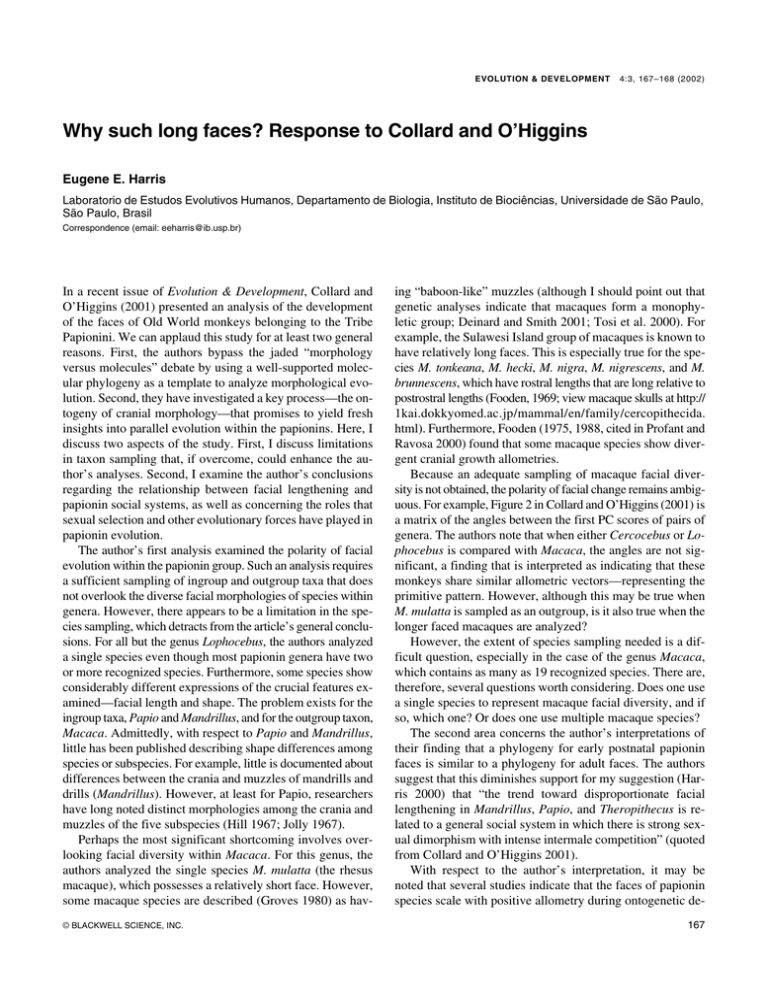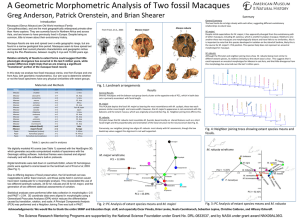Why such long faces? Response to Collard and O’Higgins
advertisement

EVOLUTION & DEVELOPMENT 4:3, 167–168 (2002) Why such long faces? Response to Collard and O’Higgins Eugene E. Harris Laboratorio de Estudos Evolutivos Humanos, Departamento de Biologia, Instituto de Biociências, Universidade de São Paulo, São Paulo, Brasil Correspondence (email: eeharris@ib.usp.br) In a recent issue of Evolution & Development, Collard and O’Higgins (2001) presented an analysis of the development of the faces of Old World monkeys belonging to the Tribe Papionini. We can applaud this study for at least two general reasons. First, the authors bypass the jaded “morphology versus molecules” debate by using a well-supported molecular phylogeny as a template to analyze morphological evolution. Second, they have investigated a key process—the ontogeny of cranial morphology—that promises to yield fresh insights into parallel evolution within the papionins. Here, I discuss two aspects of the study. First, I discuss limitations in taxon sampling that, if overcome, could enhance the author’s analyses. Second, I examine the author’s conclusions regarding the relationship between facial lengthening and papionin social systems, as well as concerning the roles that sexual selection and other evolutionary forces have played in papionin evolution. The author’s first analysis examined the polarity of facial evolution within the papionin group. Such an analysis requires a sufficient sampling of ingroup and outgroup taxa that does not overlook the diverse facial morphologies of species within genera. However, there appears to be a limitation in the species sampling, which detracts from the article’s general conclusions. For all but the genus Lophocebus, the authors analyzed a single species even though most papionin genera have two or more recognized species. Furthermore, some species show considerably different expressions of the crucial features examined—facial length and shape. The problem exists for the ingroup taxa, Papio and Mandrillus, and for the outgroup taxon, Macaca. Admittedly, with respect to Papio and Mandrillus, little has been published describing shape differences among species or subspecies. For example, little is documented about differences between the crania and muzzles of mandrills and drills (Mandrillus). However, at least for Papio, researchers have long noted distinct morphologies among the crania and muzzles of the five subspecies (Hill 1967; Jolly 1967). Perhaps the most significant shortcoming involves overlooking facial diversity within Macaca. For this genus, the authors analyzed the single species M. mulatta (the rhesus macaque), which possesses a relatively short face. However, some macaque species are described (Groves 1980) as hav© BLACKWELL SCIENCE, INC. ing “baboon-like” muzzles (although I should point out that genetic analyses indicate that macaques form a monophyletic group; Deinard and Smith 2001; Tosi et al. 2000). For example, the Sulawesi Island group of macaques is known to have relatively long faces. This is especially true for the species M. tonkeana, M. hecki, M. nigra, M. nigrescens, and M. brunnescens, which have rostral lengths that are long relative to postrostral lengths (Fooden, 1969; view macaque skulls at http:// 1kai.dokkyomed.ac.jp/mammal/en/family/cercopithecida. html). Furthermore, Fooden (1975, 1988, cited in Profant and Ravosa 2000) found that some macaque species show divergent cranial growth allometries. Because an adequate sampling of macaque facial diversity is not obtained, the polarity of facial change remains ambiguous. For example, Figure 2 in Collard and O’Higgins (2001) is a matrix of the angles between the first PC scores of pairs of genera. The authors note that when either Cercocebus or Lophocebus is compared with Macaca, the angles are not significant, a finding that is interpreted as indicating that these monkeys share similar allometric vectors—representing the primitive pattern. However, although this may be true when M. mulatta is sampled as an outgroup, is it also true when the longer faced macaques are analyzed? However, the extent of species sampling needed is a difficult question, especially in the case of the genus Macaca, which contains as many as 19 recognized species. There are, therefore, several questions worth considering. Does one use a single species to represent macaque facial diversity, and if so, which one? Or does one use multiple macaque species? The second area concerns the author’s interpretations of their finding that a phylogeny for early postnatal papionin faces is similar to a phylogeny for adult faces. The authors suggest that this diminishes support for my suggestion (Harris 2000) that “the trend toward disproportionate facial lengthening in Mandrillus, Papio, and Theropithecus is related to a general social system in which there is strong sexual dimorphism with intense intermale competition” (quoted from Collard and O’Higgins 2001). With respect to the author’s interpretation, it may be noted that several studies indicate that the faces of papionin species scale with positive allometry during ontogenetic de167 168 EVOLUTION & DEVELOPMENT Vol. 4, No. 3, May–June 2002 velopment (Freedman 1962; articles cited in Profant and Ravosa 2000), a trend that may account for the longer faces of species with large average body sizes (Profant and Ravosa 2000). Thus, a strong allometric trend appears to characterize papionins, even if species–specific facial shapes are obtained by different positive allometric vectors (Collard and O’Higgins 2001). Furthermore, the social systems of many or all papionin species are either multimale or one-male harem-style systems in which males are usually highly aggressive toward each other and maintain strong dominance hierarchies (Barton 2000; Rendall and DiFiori 1995). These social systems are hypothesized to be evolutionarily derived (Rendall and DiFiori 1995) and appear to be maintained through extreme sexual dimorphism: males are up to twice as large as females (or even larger) and possess relatively longer faces bearing longer and sharper canines (Barton 2000; Szalay and Delson 1979). Thus, an allometric trend toward disproportionate facial lengthening within papionins is indeed likely to be related to the evolution of these social systems. The finding that strong similarities exist between Papio and Mandrillus throughout ontogeny does not, presumably, invalidate this suggestion (contra Collard and O’Higgins 2001). Although I never mentioned sexual selection per se (Harris 2000), it seems reasonable to hypothesize that this mode of selection has been an important evolutionary force in producing the long faces in papionin species. In this scenario, the allometric trend toward facial lengthening may not have originated through sexual selection but was exploited (by males) in some papionin species to enhance their reproductive success, the major requirement being that males grow to larger body sizes relative to females. In fact, the longer faces in male individuals of Papio, Macaca, and Cercocebus are achieved in large measure by extending a growth trajectory they share with females, although there is a degree of late divergence (Collard and O’Higgins 2001; Leigh and Cheverud 1991; O’Higgins et al. 2001; Profant and Ravosa 2000). This notwithstanding, sexual selection is unlikely to have operated alone in shaping papionin faces. As Collard and O’Higgins (2001) pointed out, it is likely that other evolutionary forces have played significant roles, especially in producing the close similarities in the faces of Papio and Mandrillus that are manifest throughout postnatal ontogeny. The author’s suggest nonsexual natural selection and/or developmental constraints. In the hope of revealing how these evolutionary forces have operated, as well as the proportion- ate roles they have played, it may be helpful to explore several issues. For example, beyond their close resemblance in shape, what are the precise osteological features responsible for the strong similarities between the faces of Papio and Mandrillus? Are the resemblances between young individuals and between adult individuals of these genera due to the same osteological features? Are these features tightly correlated with similar dietary habits, or do the features have a similar developmental integration in the two genera? Examining these questions will further help in unraveling how and to what extent different evolutionary forces have operated in producing the facial similarities between the long-faced papionins. REFERENCES Barton, R.A. 2000. Socioecology of baboons: the interaction of male and female strategies. In P. M. Kappeler (ed.). Primate Males: Causes and Consequences of Variation Ingroup Composition. Cambridge University Press, Cambridge, pp. 97–107. Collard, M., and O’Higgins, P. 2001. Ontogeny and homoplasy in the papionin monkey face. Evol. & Dev. 3: 322–331. Deinard, A., and Smith, D. G. 2001. Phylogenetic relationships among the macaques: evidence from the nuclear locus NRAMP. J. Hum. Evol. 41: 45–59. Fooden, J. 1969. Taxonomy and Evolution of the Monkeys of Celebes (Primates: Cercopithecidae). S. Karger, Basel, pp. 1–148. Freedman, L. 1962. Growth of muzzle length relative to calvaria length in Papio. Growth 26: 117–128. Groves, C. P. (1980). Speciation in Macaca: the view from Sulawesi. In D. G. Lindberg (ed.). The Macaques: Studies in Ecology, Behavior, and Evolution. Van Nostrand Reinhold Company, New York, pp. 84–124. Harris, E. E. 2000. Molecular systematics of the Old World monkey tribe Papionini: analysis of the total available genetic sequences. J. Hum. Evol. 38: 235–256. Hill, W. C. O. 1967. Taxonomy of the baboon. In H. Vagtborg (ed.). The Baboon in Medical Research. Vol. II. University of Texas Press, Austin, pp. 3–11. Jolly, C. J. 1967. The evolution of baboons. In H. Vagtborg (ed.). The Baboon in Medical Research. Vol. II. University of Texas Press, Austin, pp. 23–50. Leigh, S. R., and Cheverud, J. M. 1991. Sexual dimorphism in the baboon facial skeleton. Amer. J. Phys. Anthropol. 84: 193–208. O’Higgins, P., Chadfeld, P., and Jones, N. 2001. Facial growth and the ontogeny of morphological variation within and between the primates Cebus apella and Cercocebus torquatus. J. Zool. Lond. 254: 337–357. Profant, L. P., and Ravosa, M. J. 2000. Evolutionary morphology of the skull in Old World monkeys. In P. F. Whitehead and C. J. Jolly (eds.). Old World Monkeys. Cambridge University Press, Cambridge, pp. 237–268. Rendall, D., and DiFiori, A. 1995. The road less traveled: phylogenetic perspectives in primatology. Evol. Anthropol. 4: 43–52. Szalay, F., and Delson, E. 1979. Evolutionary History of the Primates. Academic Press, New York. Tosi, A. J., Morales, J. C., and Melnick, D. J. 2000. Comparison of Y chromosome and mtDNA phylogenies leads to unique inferences of macaque evolutionary history. Mol. Phyl. Evol. 17: 133–144.









